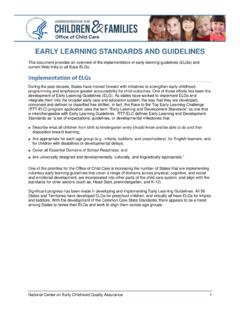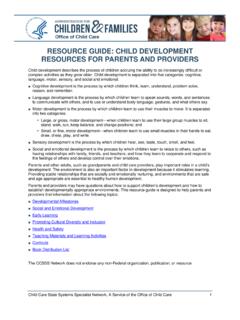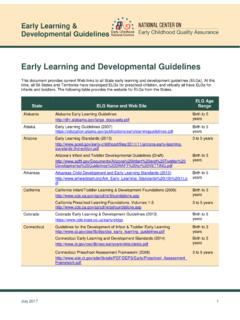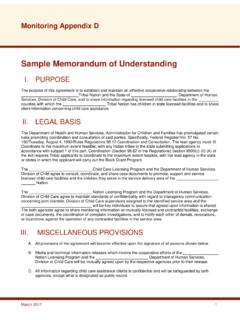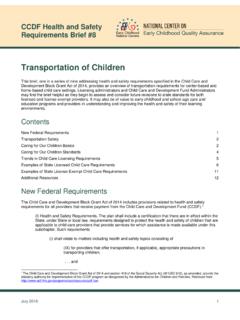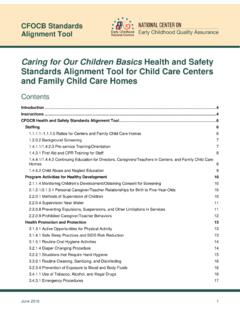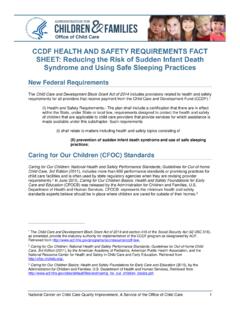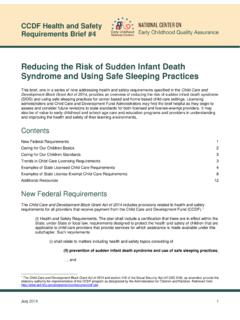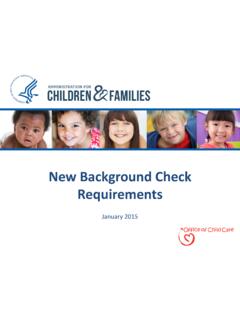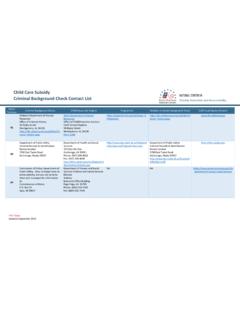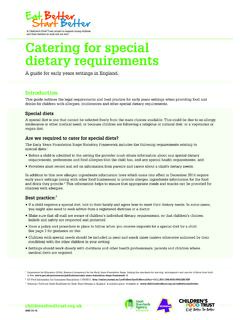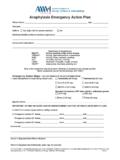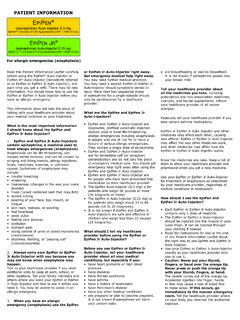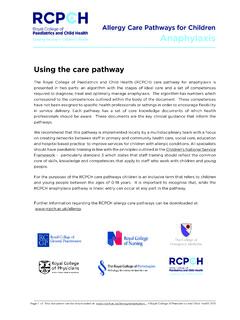Transcription of Prevention of and Response to Emergencies Due to Food …
1 CCDF Health and Safety Requirements Brief #3 July 2016 1 Prevention of and Response to Emergencies Due to food and Allergic Reactions This brief, one in a series of nine addressing health and safety requirements specified in the Child Care and Development Block Grant Act of 2014, provides an overview of the Prevention of and Response to food allergy reactions for center-based and home-based child care settings. Licensing administrators and Child Care and Development Fund Administrators may find the brief helpful as they begin to assess and consider future revisions to state standards for both licensed and license-exempt providers.
2 It may also be of value to early childhood and school-age care and education programs and providers in understanding and improving the health and safety of their learning environments. Contents Contents ..1 New Federal Requirements ..1 food allergy Facts ..2 Caring for Our Children Basics ..2 Caring for Our Children Standards ..3 Examples of State Licensed Child Care Requirements ..4 Examples of State License-Exempt Child Care Requirements ..7 Additional Resources ..8 New Federal Requirements The Child Care and Development Block Grant Act of 2014 includes provisions related to health and safety requirements for all providers that receive payment from the Child Care and Development Fund (CCDF).
3 1 (I) Health and Safety The plan shall include a certification that there are in effect within the State, under State or local law, requirements designed to protect the health and safety of children that are applicable to child care providers that provide services for which assistance is made available under this subchapter. Such requirements (i) shall relate to matters including health and safety topics consisting of (IV) the Prevention of a nd Response to Emergencies due to food and allergic reactions; 1 The Child Care and Development Block Grant Act of 2014 and section 418 of the Social Security Act (42 USC 618), as amended, provide the statutory authority for implementation of the CCDF program as designated by the Administration for Children and Families.
4 Retrieved from Prevention of and Response to food allergy Reactions July 2016 2 food allergy Facts According to a study released in 2013 by the Centers for Disease Control and Prevention , food allergies among children increased approximately 50 percent between 1997 and One in every 13 children (under 18 years of age) in the United States is affected by food allergies. That s roughly two in every A reaction to food can range from a mild Response (such as an itchy mouth) to anaphylaxis, a severe and potentially deadly In the United States, the following eight foods or food groups account for 90 percent of serious allergic reactions.
5 Milk, eggs, fish, crustacean shellfish, wheat, soy, peanuts, and tree Strict avoidance of food allergens and early recognition and management of allergic reactions to food are important measures to prevent serious health Caring for Our Children Basics Released in 2015 by the Administration for Children and Families (ACF), Caring for Our Children Basics: Health and Safety Foundations for Early Care and Education (CFOCB) represents the minimum health and safety standards experts believe should be in place where children are cared for outside their CFOCB seeks to reduce conflicts and redundancies found in program standards linked to multiple funding streams.
6 Though voluntary, ACF hopes CFOCB will be a helpful resource for States and other entities as they work to improve health and safety standards in licensing and quality rating and improvement systems. The following standard from CFOCB addresses caring for children with food allergies and includes preventative measures as well as required responses to Emergencies . Care for Children with food Allergies Each child with a food allergy should have a written care plan that includes: a) Instructions regarding the food (s) to which the child is allergic and steps to be taken to avoid that food ; b) A detailed treatment plan to be implemented in the event of an allergic reaction, including the names, doses, and methods of prompt administration of any medications.
7 The plan should include specific symptoms that would indicate the need to administer one or more medications. Based on the child's care plan and prior to caring for the child, caregivers/teachers should receive training for, demonstrate competence in, and implement measures for: a) Preventing exposure to the specific food (s) to which the child is allergic; b) Recognizing the symptoms of an allergic reaction; c) Treating allergic reactions. 2 Jackson K. D., Howie, L. D., & Akinbami, (2013). Trends in allergic conditions among children: United States, 1997 2011.
8 National Center for Health Statistics data brief. Atlanta: Ceners for Disease Control and Prevention . Retrieved from 3 food allergy Research & Education. ( ). Facts and statistics [Web page]. Retrieved from 4 food allergy Research & Education. ( ). Facts and statistics [Web page]. Retrieved from 5 Boyce J. A. , Assa ad A., Burks A. W., Jones, S. M., Sampson, H. A., Wood, R. A., .. Schwaninger, J. M. (2010). Guidelines for the diagnosis and management of food allergy in the United States: Report of the NIAID-sponsored expert panel. Journal of allergy and Clinical Immunology, 126(6),S1 S58.
9 6 food and Drug Administration, Center for food Safety and Applied Nutrition. (2010). food allergies: What you need to know. Retrieved from 7 Administration for Children and Families, Department of Health and Human Services. (2015). Caring for our children basics: Health and safety foundations for early care and education. Retrieved from Prevention of and Response to food allergy Reactions July 2016 3 The written child care plan , a mobile phone, and the proper medications for appropriate treatment if the child develops an acute allergic reaction should be routinely carried on field trips or transport out of the early care and education setting.
10 The program should notify the parents/guardians immediately of any suspected allergic reactions, as well as the ingestion of or contact with the problem food even if a reaction did not occur. The program should contact the emergency medical services system immediately whenever epinephrine has been administered. Each child s food allergies should be posted prominently in the classroom and/or wherever food is served with permission of the parent/guardian. Caring for Our Children Standards Caring for Our Children: National Health and Safety Performance Standards; Guidelines for Early Care and Education Programs, 3rd edition (CFOC3), is a collection of 686 national standards that represent best practices with respect to health and safety in early care and education settings.
